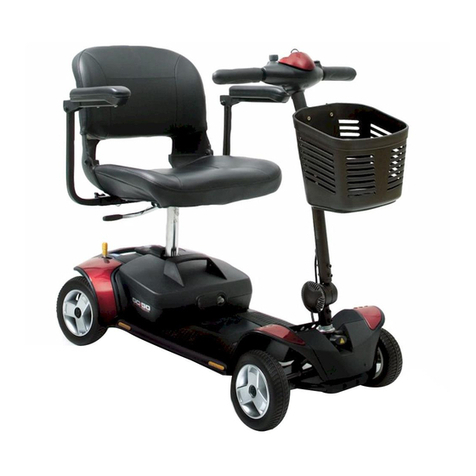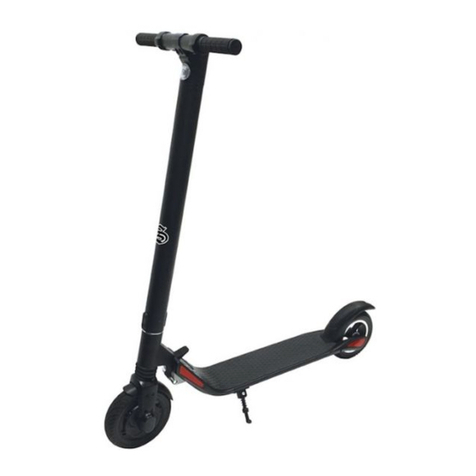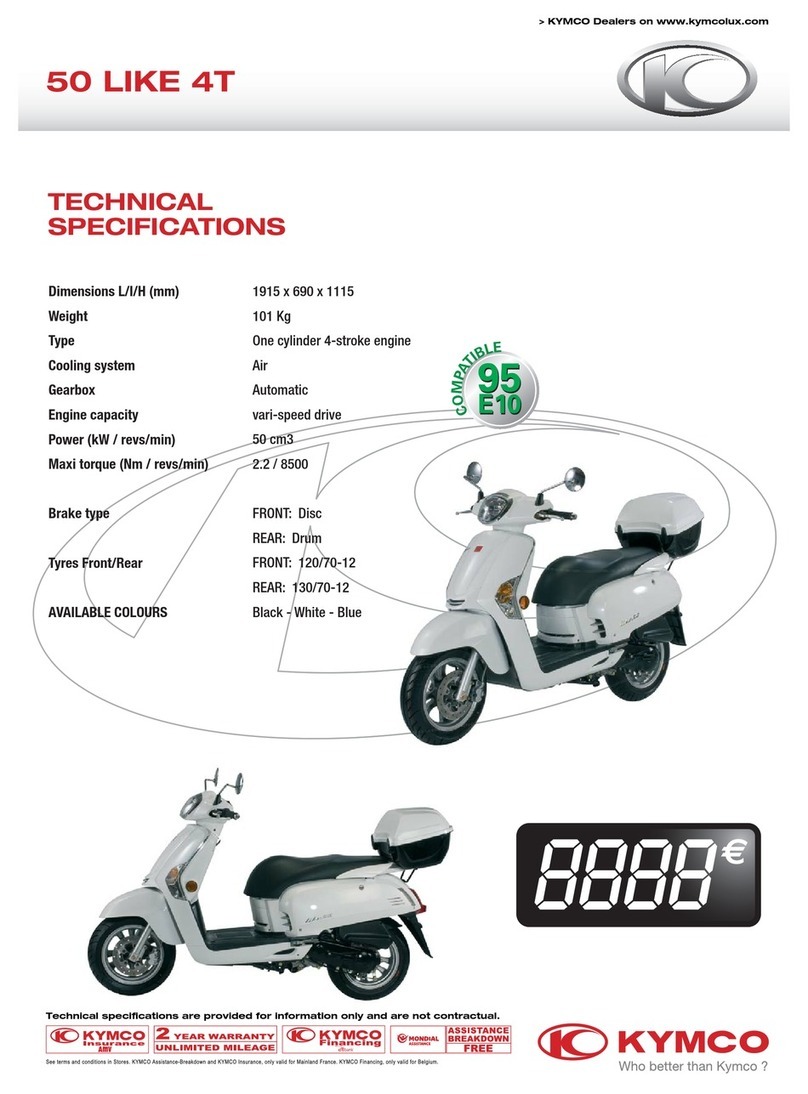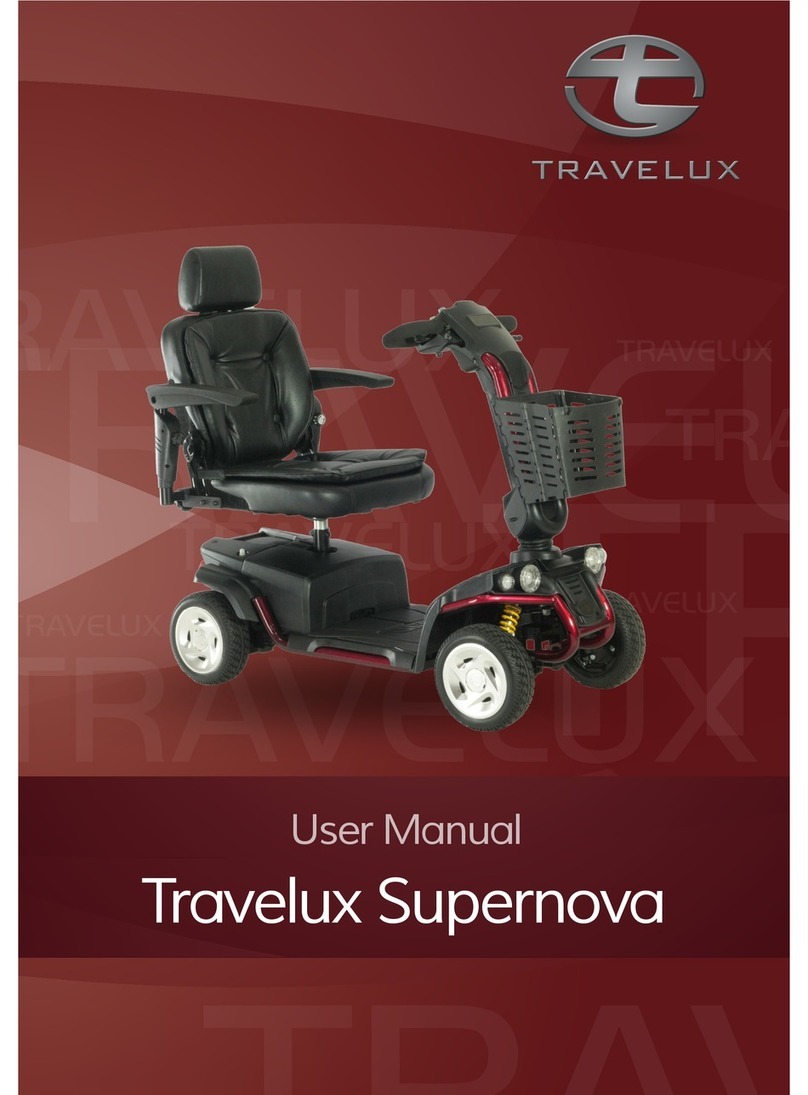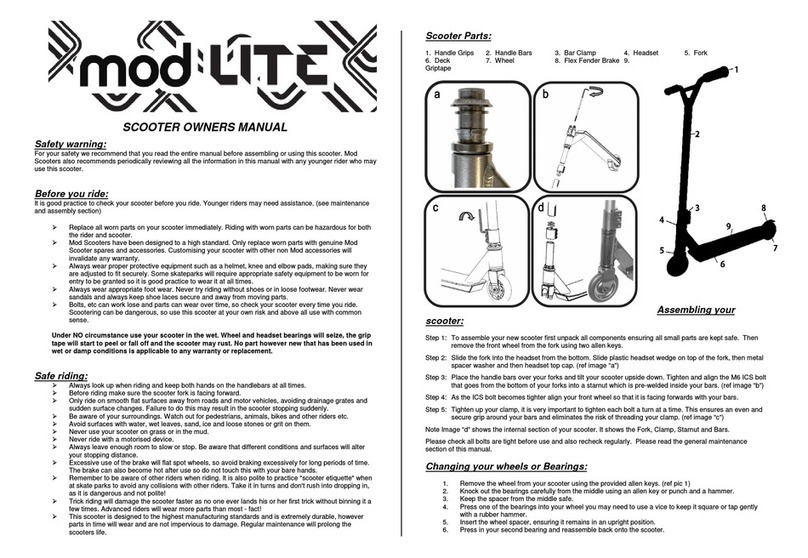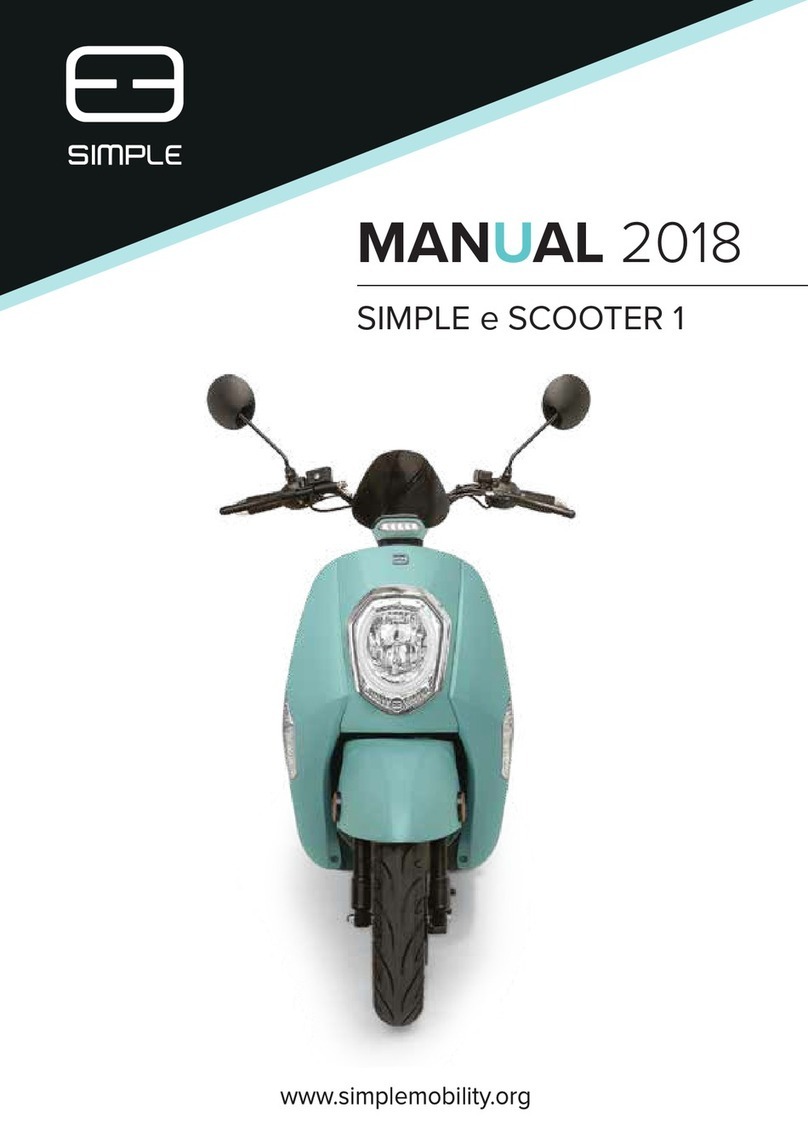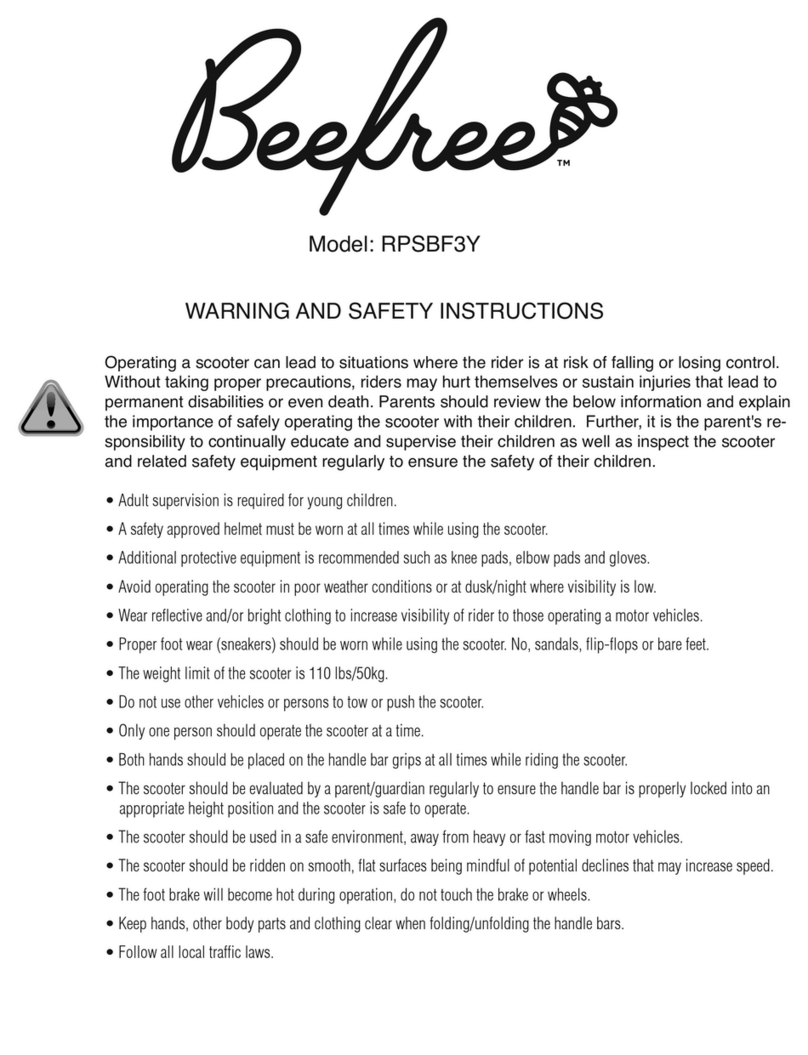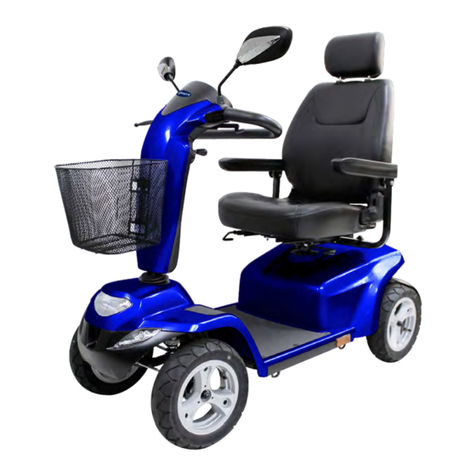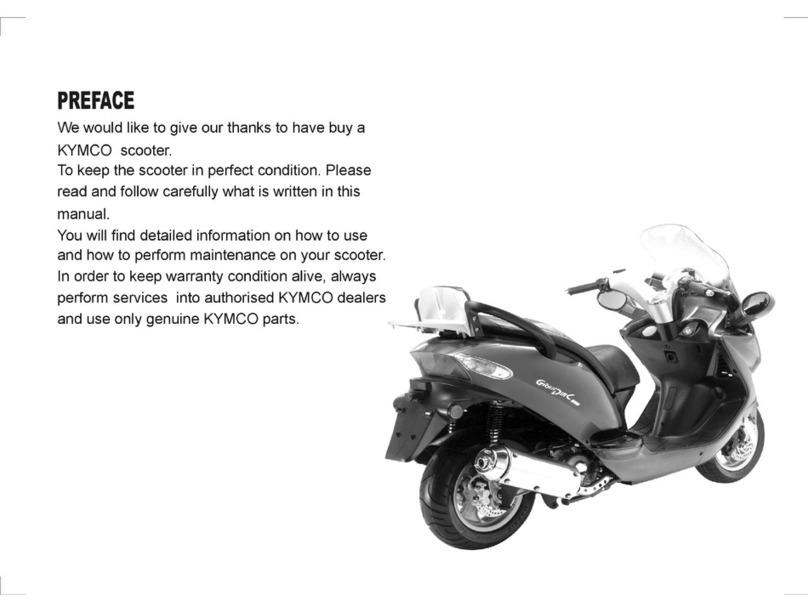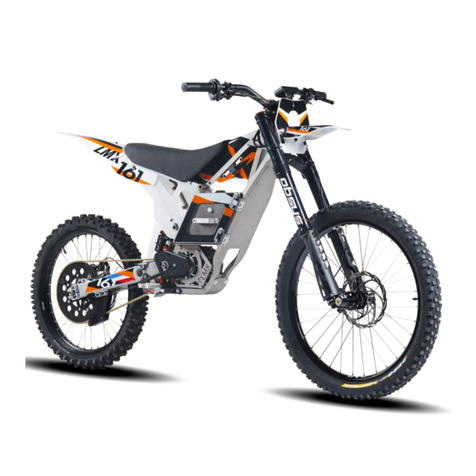Rolljet M User manual

1
OWNER'S MANUAL
www.rolljet.com
Manufactured in EU
v.09/2016
ENG

2
Thank you for your decision to purchase RollJet. We are convinced that moving around will be easier and much more fun. Numerous tests have proven that
RollJet is safe for use. Nevertheless, the use of the product in an unforeseen way, and not considering the safety recommendations, may lead to injuries or death
of the user and/or other persons. Furthermore, it may lead to destruction of RollJet and/or other property.
We call upon you to carefully read the manual prior to each use of RollJet and to provide for adequate safety measures proposed on the following pages of this
manual. We strongly advise that you pay special attention to the safety warnings and measures.
Control of the kick scooter before the ride: Prior to every use, check the entire kick scooter, if all component parts are undamaged, movable and
functional, and adequately attached and/or tightened. If you should notice any flaw or defect, do not use the kick scooter and approach a sales
person or the nearest repair shop, and replace the damaged/broken part, respectively.
Before each ride check that all screws are tightened. If necessary, use the suitable tool to tighten the screws.The use of the special glue that prevents
unscrewing is also recommended. Check the functioning of the moving parts and oil these parts if necessary. Additionally, check the T-bar height
adjustment safety catch [k]. When in lower position of the safety catch [k], T-bar is not fixed, it’s necessary to readjust the safety catch (see p. 14).
Before each use check, and if necessary remove all hair or trash (they often gather around the wheel’s bearing) to prevent mechanic damage of the
bearing. Unclean bearing may block and thus cause a fall! Long-term exposure to water, dirt etc., affects RollJet’s proper functioning. Maintain your
RollJet appropriately and thus prolong it’s lifespan.
Read carefully all the instructions for use and maintenance. Consider the safety warnings. Keep this manual in a safe place, so you can read it any time. To avoid
any risk regarding the warranty of this product, use only original RollJet spare parts.
Let fun with RollJet begin!
The RollJet Team
For additional information and RollJet Accessories visit our web page http://www.rolljet.com.
Check our web page www.rolljet.com and register to get special privileges and bonuses!
Join us on Facebook or other social networks and enter our contests!
INTRO
!
!

3
COMPONENT PARTS
RollJet Component Parts
a) Handlebar stem
b) T-bar steering rod (T-bar)
b1) Handlebar holder
c) Front wheels
d) Kick stand
e) Board
f ) Rear wheel
g) Brake
h) Button for T-bar height adjustment
i) Bag fixation and removal key
j) Board release and RollJet easy fold
button
k) T-bar height adjustment safety catch
l) Slot for bag fixation bolt
m) Bag base
n) Bag
o) Bag suspenders pocket
p) Suspenders
q) Bag fixation bolt
r) T-bar height adjustment bolt
s) Folding mechanism screw
t) Wedge under the bag
u) Air gap elimination screw

4
RollJet’ has got four height adjustment levels:
Model M:
• Level One (bottom hole) – folded RollJet / users height from
100 to 110 cm (3.28 to 3.60 ft)
• Level Two – for users up to 130 cm (4 ft) tall
• Level Three – for users up to 155 cm (5 ft) tall
• Level Four – for users up to 180 cm (5.90 ft) tall
Model L:
• Level One (bottom hole) – folded RollJet
• Level Two – for users up to 130 cm (4 ft) tall
• Level Three – for users up to 160 cm (5.24 ft) tall
• Level Four – for users up to 190 cm (6.23 ft) tall
The handlebar stem should always be pulled out SLOWLY, as by
quickly pulling it out the mechanism may get damaged.
Pravilna višina krmila:
višina bokov oz. pasu in ne višje
HEIGHT ADJUSTMENT
!
The handlebar stem is not constructed for support. It's
intended solely for changing direction with inclination.
Never PULL or PUSH AWAY the handlebar stem while driving.
By doing so your RollJet might get permanently damaged!
!
!
We recommend that the handlebar stem be adjusted to the hip or waist height. Use of RollJet is not
recommended for users lower than 100 cm (3 feet).
Med vožnjo ne vleci ali
odrivaj krmila, ki mora
biti ves čas v nevtralnem
položaju.

5
FIRST RIDE ON ROLLJET
!
Kick scooter control before the ride
Before each use check the entire kick scooter, all parts should be undamaged, movable, functional and appropriately
tightened. If you should notice any flaw or defect, do not use the kick scooter and approach a sales person
or the nearest repair shop. Before each ride check that all screws are tightened. If necessary, use the suitable tool
to tighten the screws. The use of the special glue that prevents unscrewing is also recommended. Check the fun-
ctioning of the moving parts and oil these parts if necessary. Additionally, check the T-bar height adjustment safety
catch [k]. When in lower position of the safety catch [k] T-bar is not fixed, it’s necessary to readjust the safety catch
(see p. 14). Prior to each use check, and if necessary, remove all hair or trash (they often gather around the
wheel’s bearing) to prevent mechanic damage of the bearing. Unclean bearing may block and thus cause a fall!
Before your first ride on public areas test your RollJet in a traffic free zone to get the
right feeling for riding!
!
We recommend that you should start by riding slowly on a smooth,
dry surface with no obstacles or traffic. Thus, you will easily master
the steering and turning and all additional functions provided only by
RollJet; please note that other kick scooters are not equipped with these
functions.
Start riding your RollJet by holding the T-bar (b) tight with both hands,
step on the board (e) with one foot and start to push off with the other
foot. The heel of the foot on which you are standing on the RollJet board
should be placed right in front of the brake (g) (See picture 1 a).
Should your foot be placed on the board too far front (picture 1 b) in
a sharp turn your foot may touch the front wheel and thus block it, and you may fall. Slow down by pressing the brake with the other foot above the rear
wheel (See picture 2). It is recommended that you learn to push off RollJet with your left and your right foot, so you can exchange feet from time to time
to relieve them.
When changing direction direct RollJet by tilting your body and the handlebar stem and not by rotating the handlebar stem!
Brake (g)
• Intended for slowing down on smooth surfaces. Avoid driving downhill!
• Use your free foot to gently press the brake (the metallic part above the rear wheel)!
• The higher the speed, the sooner and the stronger you need to press the brake.
• Braking must absolutely be tested on a flat surface first, with no traffic and at low speed.
• Braking on wet terrain is NOT effective, therefore the wet terrain must be crossed on foot.
1a 1b 2

6
MODES OF ROLLJET USE
RollJet with bag in
folded position.
Turn the safety handle
upwards to release
the safety catch.
Push the button for T-bar
height adjustment; then pull
out the T-bar up to the T-bar
height adjustment bolt (r) to
the suitable height.
Gently push the safety
catch for T-bar fixation (k)
downwards to fix the T-bar.
RollJet can be used
as the bag on wheels.
Preparing RollJet for use as bag on wheels:
RollJet as bag on wheels. Board release button (j)
Press the board (e) with one
hand against the T-bar and
keep in position. With the
other hand simultaneously
gently …
… pull the board release
button (j). By doing so the
board is released. Lower it on
the ground; at the same time
let go off the button (j).
Make sure that the
mechanism is properly
stuck! RollJet is now in
driving position.
Preparing RollJet for driving position:
1
2
3
1
2

7
MODES OF ROLLJET USE
Lean the front part of your
foot on the board (e); for
better support your heel
should stay on the ground.
The T-bar should be pulled
forward; push the board
release button (j) and tilt the
T-bar against the board and
let go off the button.
1. Fold the T-bar against
the board until you hear
the mechanism click.
2. Turn the safety handle (k)
in the upright position
– released.
Push the T-bar height adju-
stment button; lower the T-bar
down to the bottom in the
lower (folded) position. Turn the
safety handle (k) down.
Folding your RollJet:
Filling the Bag Properly:
-Start filling the bag with heavier objects at the back, behind the partition. When the back part is filled, start
filling other parts of the bag with lighter objects.
-It is very important to fill the bag symmetrically in order to provide stability and proper carrying of the bag.
Loading the bag inappropriately may cause losing balance while riding and you may fall. While carrying
inappropriately loaded bag your back may hurt.
-Never overload the bag!
-Do not sit on the bag!
-Never carry a bag heavier than 20 % of your body weight. Always use it only as the bag on wheels!
!
1 2
1
2
2
3
1

8
MODES OF ROLLJET USE
Under the board release
button (j) there is an oblong
key for setting and removing
the bag.
Press the key (i)
downwards and keep
it in this position!
www.rolljet.com
When the bolts on the
bag are released, take
the bag off and release
the key (i).
Removing the Bag from RollJet:
While setting the bag (n)
mind the wedge (t) on the
bag bottom and the bag
seating (m) on RollJet.
Tilt RollJet into position as
shown on the picture!
… the bag fixation key (i).
Push the bag (o) towards
the T-Bar holder (a)!
Metallic bolts (s) on the
bag should sit in the bag
seating (m) on RollJet.
The wedge (v) should sit in
the bag seating (n). Simulta-
neously press and hold …
Setting the Bag on RollJet:
With the bag in its
place, release the bag
fixation key (i) and gently
push it upwards.
[n] 3
2
1
2
1
2

9
WHEELS AND BOARD PROTECTION
Večji del prevleke
za desko in zadnje kolo ter
manjši del prevleke za
sprednja kolesa.
RollJet as a backpack. Use of the third suspender. The third suspender
storage pocket.
Some RollJet bag models
have additional wheels …
… and a pull-out handle to
use it as the bag on wheels.
Večji del prevleke
poveznite preko zadnjega
kolesa in zavore.
Prevleko potegnite
do konca deske.
Manjši del prevleke
poveznite preko enega
in nato še preko drugega
kolesa.
Mehka prevleka za
lažje shranjevanje.
When we wish to use the entire RollJet as a shoulder bag, a neoprene cover can be used as protection for the wheels/board. It protects
our clothes from dirt and the sensation on our back is softer and more pleasant.

10
WARNINGS AND PRECAUSTIONS
• Before use carefully read the instructions.
• Wearing a helmet and knee, elbow and hand pads is recommended.
• Always stand on RollJet with one foot only! Riding RollJet with both feet simultaneously is not recommended.
• RollJet is not a toy. Do not allow children under the age of five (5) to use the kick scooter. Intended age group of RollJet users
is from 5 to 55 years.
• Maximum recommended speed is 12 km/h (7,5 mph). Adjust the speed when riding on pedestrian areas in line with traffic regulations
and driving conditions.
• RollJet is not suitable for acrobatic stunt performances.
• Improper use of this product may result in serious injury or even death!
• Never ride on wet surface!
• Before each ride check if all the screws and component parts are tightly fastened. Check the condition of wheels, breaks and other
component parts.
• Every time clean all hair and rubbish around the wheel’s axis if necessary, as they may cause mechanic damage of bearings. A bearing
may block and consequently cause a fall!
• While riding always look straight ahead! Before changing direction always make sure the path is free and safe!
• Ride only on level surfaces, e.g. asphalt or concrete.
• Use RollJet at your own risk and only in line with your capabilities.
• When riding RollJet always use appropriate safety equipment, which is commonly used for inline skating and roller skating (helmed,
knee, elbow and palm pads). Only one person at a time should be riding RollJet.
• Maximum recommended speed is 12 km/h (7,5 mph). Adjust the speed when riding on pedestrian areas in line with traffic regulations
and driving conditions. Keep safety distance from other traffic participants, persons or objects. We recommend that you use RollJet on
urban surfaces only where there are no motor vehicles. When riding RollJet abide by traffic regulations.
• RollJet user must be entirely healthy and must be able to keep a steady balance.
• While riding hold on to the T-bar handle all the time! Caution! The handlebar stem is not constructed for support. It's intended solely
for changing direction with inclination. Before the ride always fix the T-Bar height adjustment safety catch [k]
• RollJet is not intended as a walking aid.
• Never touch the T-bar safety catch and the button for T-bar height adjustment while riding to prevent releasing the safety catch.
• It’s not recommended to ride RollJet on the areas where there are many pedestrians or areas where traffic is dense. Adjust riding speed
to the conditions on the driving surface and its surroundings.
!

11
!
• RollJet must not be used on roads and other driving areas intended for motor vehicles!
• Don’t ride in the crowd and abide good manners!
• The RollJet bag must not be thrown, and don’t sit on the bag either! Throwing and sitting on the bag may result in perma-
nent damage of the bag.
• If you feel any pain or unpleasant feelings during the ride, you must immediately stop using RollJet.
• Always stand on RollJet with one foot only! Riding RollJet with both feet simultaneously is not recommended.
• Never use RollJet under the influence of alcohol, medications or narcotics.
• Don’t use RollJet on wet, greasy and uneven surfaces! Always step down from RollJet, fold it and carry it over such surfaces. Wet terrain
reduces RollJet breaking system effectiveness.
• It’s recommended that you are familiar with the terrain you intend to ride your RollJet on. If you don’t know the terrain, we recommend
that you scrutinize the surface and avoid possible damages on the road. Thus you will avoid the danger of falling.
• To prevent slipping off the board, always wear serrated-sole footwear. Watch the quality / wear and tear of the anti-slip coating!
• Always stand on RollJet with one foot only, never with both feet!
• Never use RollJet barefoot - brakes get hot from use and you may get burned.
• Do not drive in rainy or snowy weather, and immediately after the rain when driving surfaces are wet and slippery.
• Never drive across the road on RollJet! Always cross the road on pedestrian crossings! When crossing the road, RollJet must be at least
partly folded (in the bag-on-wheels position). When you are crossing the road, pull RollJet behind you or carry it on your shoulder.
• RollJet is not a toy. Do not allow children under the age of five (5) to use the kick scooter. Intended age group of RollJet users is from 5
to 55 years.
• When riding at dusk, dark or fog always use reflective objects or pulsating lights.
• RollJet is not suitable for acrobatic stunt performances.
• Don’t ride your RollJet in schools or other public places where riding a kick scooter is not allowed!
• Beware of various obstacles such as slits and dents on the road surface, as the wheels may get stuck and stop RollJet instantly which
may result in falling.
• Exceeding carrying capacity of RollJet may cause malfunctioning of RollJet’s mechanisms, bolts and breaks. Improper load can perma-
nently damage RollJet.
• During the ride never reach with your hands into the area of product’s movable parts.
• Avoid riding RollJet at poor visibility – e.g. in fog or at night.
WARNINGS AND PRECAUSTIONS

12
Insert the hexagon
screw spanner into the
screw head and keep
turning it counter-cloc-
kwise until unwound.
Take the old wheel
off and replace it
with the new one.
1 2 3 4 5
RollJet Maintenance
The product’s lifespan depends on proper maintenance, so take good care of your RollJet! Cleanse it thoroughly with
half-damp cloth and gentle cleansing product regularly, especially after using RollJet in bad weather conditions or in
dusty environment. At least once a month or frequently if necessary, apply a drop of oil on movable parts. It is especially
recommended to grease the rotatory axis of the front chassis – above and below (picture 1), the bolt of the folding mechanism - above
and below (pictures 2 and 3), the bag locking mechanism (picture 4) and the folding mechanism axis (picture 5). The residual grease
should be always wiped-off with a clean cloth.
Changing wheels and bearings
Due to rough surfaces and braking on asphalt or concrete the wheels wear in time. For a safe
ride it’s necessary to replace all worn out wheels and bearings. Due to braking and riding
in your own way, all three wheels may not wear out simultaneously. Regularly check all the
wheels for wear and tear. It is obligatory to use only genuine RollJet spare parts as they
have proper dimensions and meet RollJet quality standards. When changing wheels it is
recommended to change the bearings, too.
Changing the Front Wheel [c]
To replace the front wheel you need a 3 mm (0.118 inch) hexagon (hollow) screw spanner.
When assembling anew, some glue should be applied to the screws to prevent unwinding.
MAINTENANCE
!

13
MAINTENANCE
Insert the first hexagon screw
spanner into the left screw head
slot to keep it in place. Insert the
second hexagon screw spanner
into screw head slot on the
opposite side and keep turning it
counter-clockwise to unscrew
one of the screws.
Put the flat screwdriver into
the opening (where there is no
screw) and use the 4 mm (0.157
inch) hexagon screw spanner
to unwind the second screw on
the opposite side. Now you can
take off the wheel and the axis.
Using the flat screwdriver
remove the axis and insert it
in the new wheel.
Add an 8 mm (0.31 inch) dia-
meter washer on each side of
the wheel and tighten them
with two screws (M6x12) to
the RollJet base (chassis).
When assembling anew,
apply some glue to the
screws to prevent
unscrewing.
Changing the Rear Wheel [f]
For changing the rear wheel you need two 4 mm (0.157 inch) hexagon (hollow) screw spanners and a flat screwdriver.
Board replacement [e]
To replace the board you need a 3 mm (0.118 inch) hexagon screw spanner (back part of the board) and a 4 mm (0.157 inch) hexagon screw spanner (front
part of the board).
1. Remove all screws and replace the board;
2. When assembling anew, apply some glue to the screws to prevent unscrewing. Tighten the new board firmly back to RollJet.

14
12 3 4a 4b
Re-setting the T-bar height adjustment safety catch (k)
After a few weeks of RollJet use the T-bar height adjustment safety catch will probably need some re-setting. To re-set the height ad-
justment handle you need a 3 mm (0.118 inch) hexagonal screw spanner. Hold the handle with one hand. At the same time, insert the
screwdriver into the screw hole and keep turning it counterclockwise to the point where you can remove the safety catch [k] (unwinding
is made difficult for safety reasons) [picture 1]. 1. Place the safety catch with no screw or washer on the cogwheel and keep turning it
clockwise until lifting and lowering of T-bar in its bottom position is still possible, but difficult (picture 2). Take the safety catch handle off
the cogwheel and place it again on RollJet in the position of the released T-bar (upper position – the handle is turned upwards). Before
assembling anew, check the screw and apply some glue if necessary, to prevent unscrewing (picture 3). Hold the handle in the upper
position (picture 4a) and tighten it with the screw and the washer to the cogwheel (picture 4b).
Kick stand replacement (d)
To replace the kick stand you need a 3 mm (0.118 inch) hexagon screw spanner.
1. Unwind all the screws on the kick stand and replace it;
2. When assembling anew, apply some glue to the crews to prevent unscrewing. Tighten the new kick stand
with screws to the RollJet base.
Air gap setting between the T-bar and the chassis
When using RollJet for some time, an air gap between the T-bar and the chassis may appear. The air gap could be
set with a screw (v). Turn the screw (v) counterclockwise with a 2,5 mm (0.078 inch) hexagon screw spanner for
approximately one quarter of a turn (90 °) and keep testing air gap as well as functioning of the entire mechanism.
Repeat the procedure until air gap between the T-bar and the chassis is eliminated. The first turn of the screw may
be more difficult due to glue preventing unwinding of the screw. In case the screw has been unwound too much,
the mechanism will not get stuck in open position, and the screw needs some tightening in clockwise direction.
MAINTENANCE

15
!
TECHNICAL SPECIFICATIONS
RollJet is designed according to SIST EN 14619:2005 - Roller sports equipment - Kick scooters - Safety requirements and test
methods ; ICS:97.22.40 - Outdoor and water sports equipment.
RollJet Kick Scooter M L
Maximum user weight 100 kg (220.46 Lb) 100 kg (220.46 Lb)
Maximum user height 180 cm (5.9 ft) 190 cm (6.2 ft)
Maximum dimension of folded RollJet with bag (height,
width, depth)
h= 60 – 62 cm*, w= 37 cm, d = 25 – 40 cm
[h = 24 in, w = 14.56 in, d = 9.84 to 15.74 in]
h = 69 cm, w = 37 cm, d= 25 – 40 cm
[h = 27.16 in, w = 14.56 in, d = 9.84 to 15.74 in]
Maximum dimension of unfolded (open) RollJet with bag h= 94 cm, w = 37 cm,
t= 60 -75 cm
[h = 37.00 in, w = 14.56 in, t = 23.62. to 29.53 in]
h = 101 cm, w = 37 cm, t = 67 -82 cm
[h = 3.31 ft, w = 14.56 in,
t = 26.37 to 32.28 in]
RollJet Weight 2,7 kg (4.40 Lb) 3,0 kg (6.61 Lb)
Board Length 40 cm (1.31 ft) 47 cm (1.54 ft)
*depending on the size of the wheels
RollJet BAGS* Outer Dimensions Load Capacity/ Volume Empty Bag Weight With Handle and Wheels
From h = 43 cm, w = 30 cm, d = 15 cm
[h = 16.92 inch, w = 11.81 inch, d = 5.90 inch]
5 kg (11.02 Lb) / 15 l 1,0 kg (2.20 Lb) /
To h = 50 cm, w = 39 cm, d = 35 cm
[h = 19.68 inch, w = 15.35 inch, d = 13.77 inch]
12 kg (26.45 Lb) / 32 l 2.2 kg (4.85 Lb) 2.8 kg (6.17 Lb)
*The measures stated are only for informative purposes and depend on the chosen model of the bag. We allow ourselves to change dimensions without prior notice.
Before travelling by plane, check with the airline company, if RollJet is allowed as passenger cabin baggage.
The maximum recommended speed on dry and smooth terrain is 12 km/h (7.45 mph).
STORE YOUR ROLLJET IN A WARM AND DRY PLACE!

16
RollJet
SHOWROOM
Gerbičeva 102, 1000 Ljubljana
tel: +386 1 320 6000
e-mail: [email protected]
Working hours: 8:00-18:00
Closed on Saturdays, Sundays and holidays
www.RollJet.com
WARRANTY
Salesman: ________________________________________
Customer: ________________________________________
Date of purchase: ________________________________________
Serial number: ________________________________________
Salesman’s seal & signature: ________________________________________
• The warranty is valid for 12 months from the date of purchase.
• Noncompliance of recommendations and instructions may invalidate the
warranty.
• Warranty may be enforced only upon submission of a validated official war-
ranty certificate and an invoice.
• Warranty applies to RollJet kick scooter production and materials.
WARRANTY EXCLUDES
• Consumable parts, such as wheels, bearings, kick stand, handles;
• The bag;
• Noncompliance of safety precautions;
• Normal wear and tear of wheels and frame;
• Aggressive cleansers usage;
• Acrobatic stunt performance or riding on unsuitable terrain;
• Unapproved self-repair and modifications of the scooter;
• Any damage or failure of RollJet caused by improper use;
• Any damage or failure caused by riding and using RollJet with worn out parts which unambiguously needed replacement prior to
the damage;
• Any damage of RollJet due to using it in inconvenient weather conditions (e.g. rain, snow … - rust, soaked board, etc.).
This manual suits for next models
1
Table of contents
